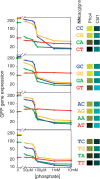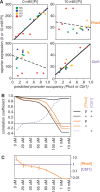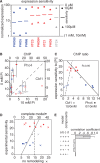Differential binding of the related transcription factors Pho4 and Cbf1 can tune the sensitivity of promoters to different levels of an induction signal
- PMID: 23558744
- PMCID: PMC3643608
- DOI: 10.1093/nar/gkt210
Differential binding of the related transcription factors Pho4 and Cbf1 can tune the sensitivity of promoters to different levels of an induction signal
Abstract
Transcription factors that belong to the same family typically have similar, but not identical, binding specificities. As such, they can be expected to compete differentially for binding to different variants of their binding sites. Pho4 is a yeast factor whose nuclear concentration is up-regulated in low phosphate, while the related factor, Cbf1, is constitutively expressed. We constructed 16 GFP-reporter genes containing all palindromic variants of the motif NNCACGTGNN, and determined their activities at a range of phosphate concentrations. Pho4 affinity did not explain expression data well except under fully induced conditions. However, reporter activity was quantitatively well explained under all conditions by a model in which Cbf1 itself has modest activating activity, and Pho4 and Cbf1 compete with one another. Chromatin immunoprecipitation and computational analyses of natural Pho4 target genes, along with the activities of the reporter constructs, indicates that genes differ in their sensitivity to intermediate induction signals in part because of differences in their affinity for Cbf1. The induction sensitivity of both natural Pho4 target genes and reporter genes was well explained only by a model that assumes a role for Cbf1 in remodeling chromatin. Our analyses highlight the importance of taking into account the activities of related transcription factors in explaining system-wide gene expression data.
Figures






Similar articles
-
Integrated approaches reveal determinants of genome-wide binding and function of the transcription factor Pho4.Mol Cell. 2011 Jun 24;42(6):826-36. doi: 10.1016/j.molcel.2011.05.025. Mol Cell. 2011. PMID: 21700227 Free PMC article.
-
Reb1, Cbf1, and Pho4 Bias Histone Sliding and Deposition Away from Their Binding Sites.Mol Cell Biol. 2022 Feb 17;42(2):e0047221. doi: 10.1128/MCB.00472-21. Epub 2021 Dec 13. Mol Cell Biol. 2022. PMID: 34898278 Free PMC article.
-
A dominant suppressor mutation of the met30 cell cycle defect suggests regulation of the Saccharomyces cerevisiae Met4-Cbf1 transcription complex by Met32.J Biol Chem. 2008 Apr 25;283(17):11615-24. doi: 10.1074/jbc.M708230200. Epub 2008 Feb 28. J Biol Chem. 2008. PMID: 18308733 Free PMC article.
-
Nutrient-regulated antisense and intragenic RNAs modulate a signal transduction pathway in yeast.PLoS Biol. 2008 Dec 23;6(12):2817-30. doi: 10.1371/journal.pbio.0060326. PLoS Biol. 2008. PMID: 19108609 Free PMC article.
-
Transcription factors vs nucleosomes: regulation of the PHO5 promoter in yeast.Trends Biochem Sci. 1997 Mar;22(3):93-7. doi: 10.1016/s0968-0004(97)01001-3. Trends Biochem Sci. 1997. PMID: 9066259 Review.
Cited by
-
Core promoter sequence in yeast is a major determinant of expression level.Genome Res. 2015 Jul;25(7):1008-17. doi: 10.1101/gr.188193.114. Epub 2015 May 12. Genome Res. 2015. PMID: 25969468 Free PMC article.
-
In pursuit of design principles of regulatory sequences.Nat Rev Genet. 2014 Jul;15(7):453-68. doi: 10.1038/nrg3684. Epub 2014 Jun 10. Nat Rev Genet. 2014. PMID: 24913666 Review.
-
Predicting the impact of promoter variability on regulatory outputs.Sci Rep. 2015 Dec 17;5:18238. doi: 10.1038/srep18238. Sci Rep. 2015. PMID: 26675057 Free PMC article.
-
De novo distillation of thermodynamic affinity from deep learning regulatory sequence models of in vivo protein-DNA binding.bioRxiv [Preprint]. 2023 May 11:2023.05.11.540401. doi: 10.1101/2023.05.11.540401. bioRxiv. 2023. PMID: 37214836 Free PMC article. Preprint.
-
Genomics pipelines to investigate susceptibility in whole genome and exome sequenced data for variant discovery, annotation, prediction and genotyping.PeerJ. 2021 Jul 26;9:e11724. doi: 10.7717/peerj.11724. eCollection 2021. PeerJ. 2021. PMID: 34395068 Free PMC article.
References
-
- Johnson AD, Poteete AR, Lauer G, Sauer RT, Ackers GK, Ptashne M. λ Repressor and cro—components of an efficient molecular switch. Nature. 1981;294:217–223. - PubMed
Publication types
MeSH terms
Substances
LinkOut - more resources
Full Text Sources
Other Literature Sources
Molecular Biology Databases
Research Materials

